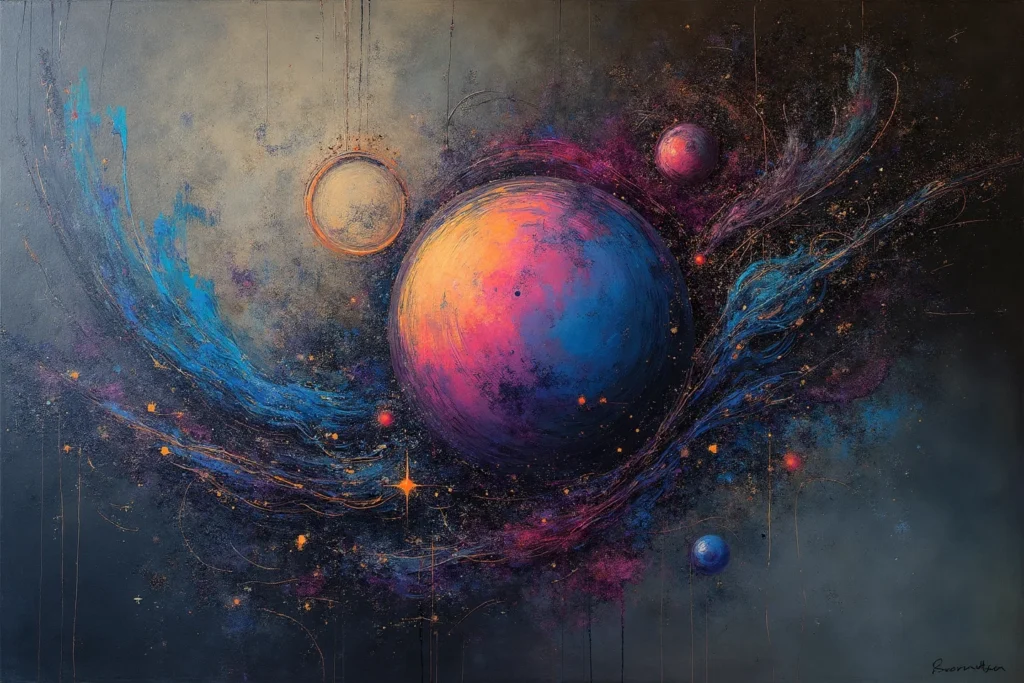Abdel Hadi Al Gazzar (1925-1966) remains a luminous figure in the annals of modern Egyptian art. He is celebrated for his profoundly symbolic and mystical artwork, which delves deep into the realms of spirituality and folklore. Born in Alexandria and settling in Cairo, Al Gazzar’s early exposure to cosmopolitan and traditional cultures profoundly shaped his artistic journey.
Artistic Themes and Motifs
Al Gazzar’s canvases are studies in complexity. He weaves dense narratives through spiritual symbolism and motifs from Egyptian folklore. His work often delves into themes of existence, exploring the mystical and metaphysical aspects of life through vivid and evocative imagery.
Early Works
In his formative years, Al Gazzar’s style was significantly influenced by his immediate environment. It was characterized by intricate attention to the socio-cultural and religious intricacies of his homeland. Works like “Sufi’s Dua” provide a window into his early artistic concerns and stylistic experiments.
The Cairo Art Movement
As a pivotal member of the Contemporary Art Group in Cairo, Al Gazzar helped spearhead a movement that sought to infuse Egyptian art with modernist aesthetics while staying rooted in indigenous culture. His contributions during this era were seminal in shaping a new visual vocabulary for Egyptian artists.
Major Artworks
“The Carnival” and “The Unknown Prisoner” testify to Al Gazzar’s genius. They showcase his ability to blend local cultural narratives with universal themes of freedom and human suffering. These pieces are celebrated for their intricate detail and emotional depth.

Technique and Style
Al Gazzar’s technique is distinguished by his textured use of color and the integration of traditional Egyptian artistic forms with modernist techniques. His style evolved to include abstract elements, complementing his thematic focus on spiritual and mythological subjects.
Symbolism in Al Gazzar’s Art
His paintings are replete with symbols drawn from Egyptian religious and cultural texts, embedded within the layers of his work to create a tapestry of meaning that invites multiple interpretations and offers a rich narrative experience.
Political and Social Commentary
Through his art, Al Gazzar commented on Egypt’s socio-political landscape, subtly critiquing the rapid modernization post-revolution while mourning the loss of cultural innocence and spiritual depth.
Exhibitions and Recognition
Al Gazzar’s work has been showcased in numerous exhibitions in Egypt and internationally, securing his place as a significant figure in the global art scene. His contributions have been recognized with several prestigious awards, underscoring his impact on art.
Influence on Other Artists
Mentoring younger artists and engaging in various collaborations, Al Gazzar left an indelible mark on the Egyptian art community, inspiring a generation of artists to explore deeper cultural and spiritual themes.
The Spiritual Connection
Al Gazzar’s art’s spiritual elements reflect his quest for transcendence and understanding, w. Many of his pieces explore themes that resonate with quests for divine love and knowledge.
Collection and Preservation
Today, Al Gazzar’s artworks are preserved in several significant collections worldwide, including the Museum of Modern Egyptian Art in Cairo and other international institutions, safeguarding his legacy.
Artistic Collaborations
Throughout his career, Al Gazzar engaged in significant artistic collaborations that enriched his work, allowing him to explore and integrate diverse artistic perspectives and techniques.
Critical Reception
Critics have lauded Al Gazzar for his unique approach to depicting traditional themes with a modernist twist, noting his work as a bridge between past and contemporary narratives.
Comparison with Peers
Compared with contemporaries such as Hussein Bicar and Salah Taher, Al Gazzar’s work is distinct in its intricate use of symbolism and deeper spiritual undertones, setting him apart in the pantheon of Egyptian artists.
The Role of Art in Cultural Identity
Al Gazzar viewed art as a vital expression of cultural identity, using his canvas to debate and discuss the essence of Egyptian culture in a rapidly changing world.
Personal Struggles and Artistic Output
Personal challenges, particularly his health issues, profoundly influenced Al Gazzar’s artistic output, imbuing his works with a somber, introspective quality that mirrors his trials.
Evolution Over Time
Al Gazzar’s thematic and stylistic elements underwent significant evolution throughout his career, marked by an increasing abstraction and complexity in his later works.
Public and Private Collections
Al Gazzar’s works are held in public and private collections, attesting to their enduring appeal and high global esteem.
Conclusion
Abdel Hadi Al Gazzar’s legacy as an artist who adeptly balanced traditional themes with modern techniques continues to influence and inspire. His works offer a profound commentary on the human condition, rendered through a uniquely Egyptian and universally relatable lens.
